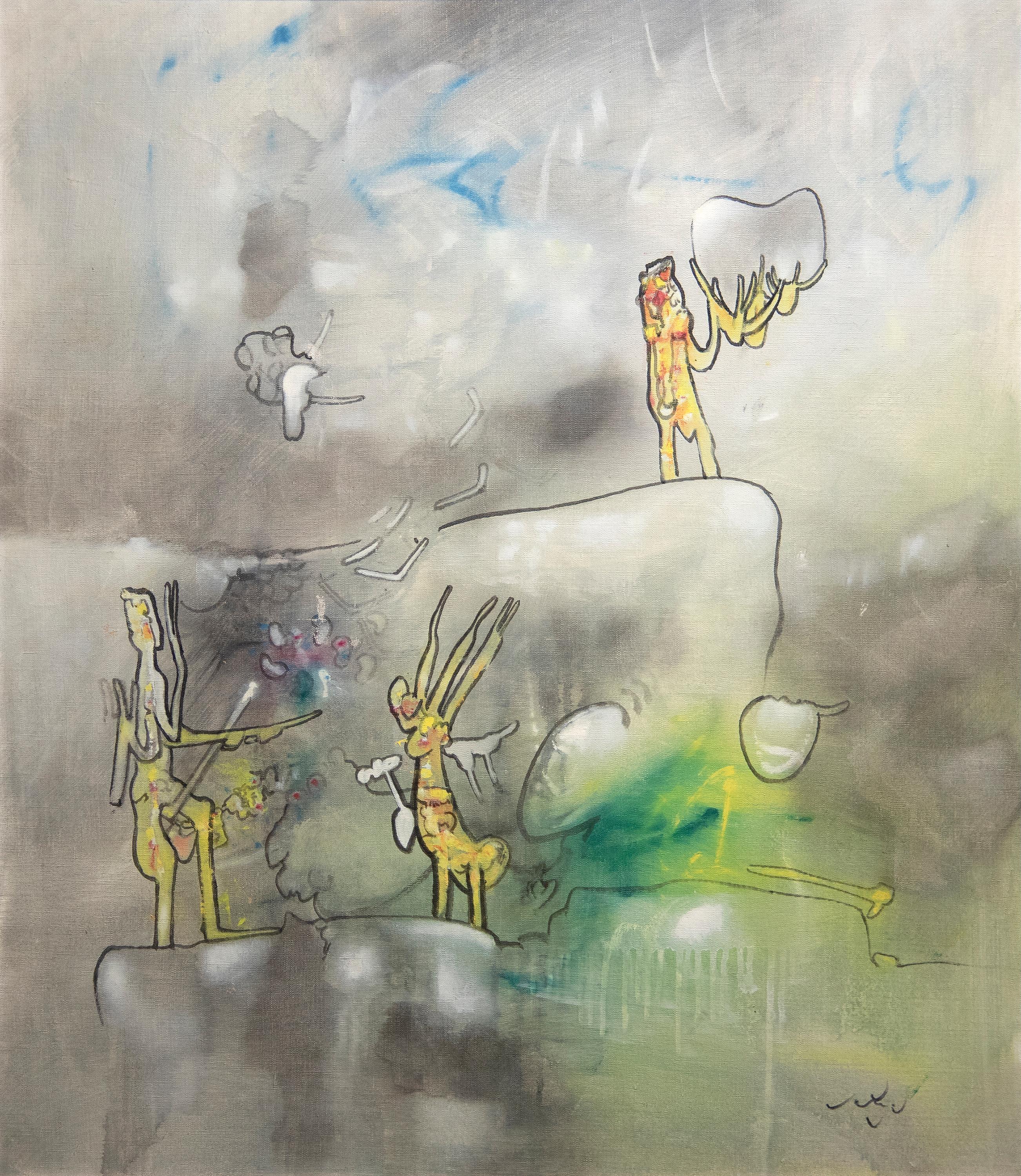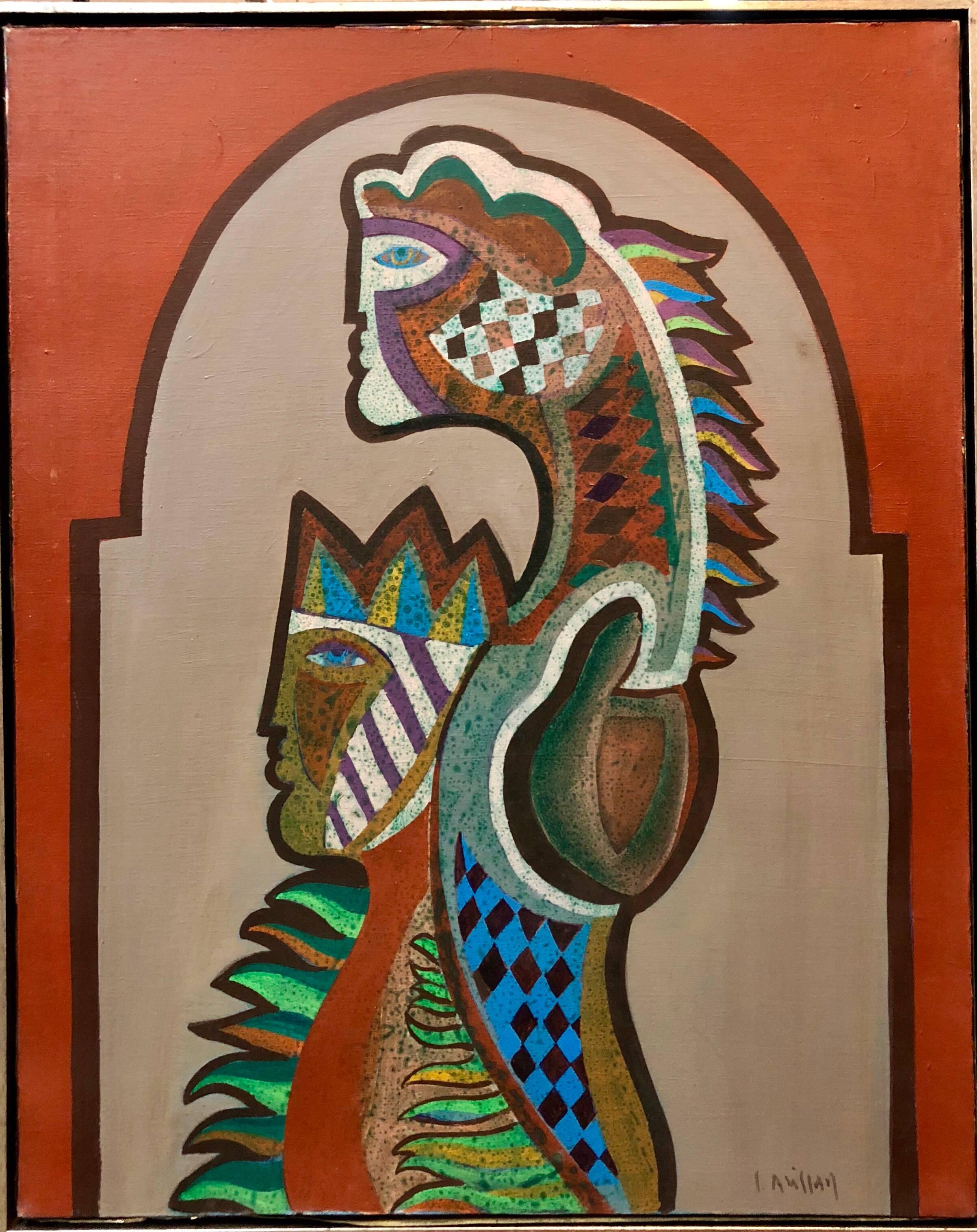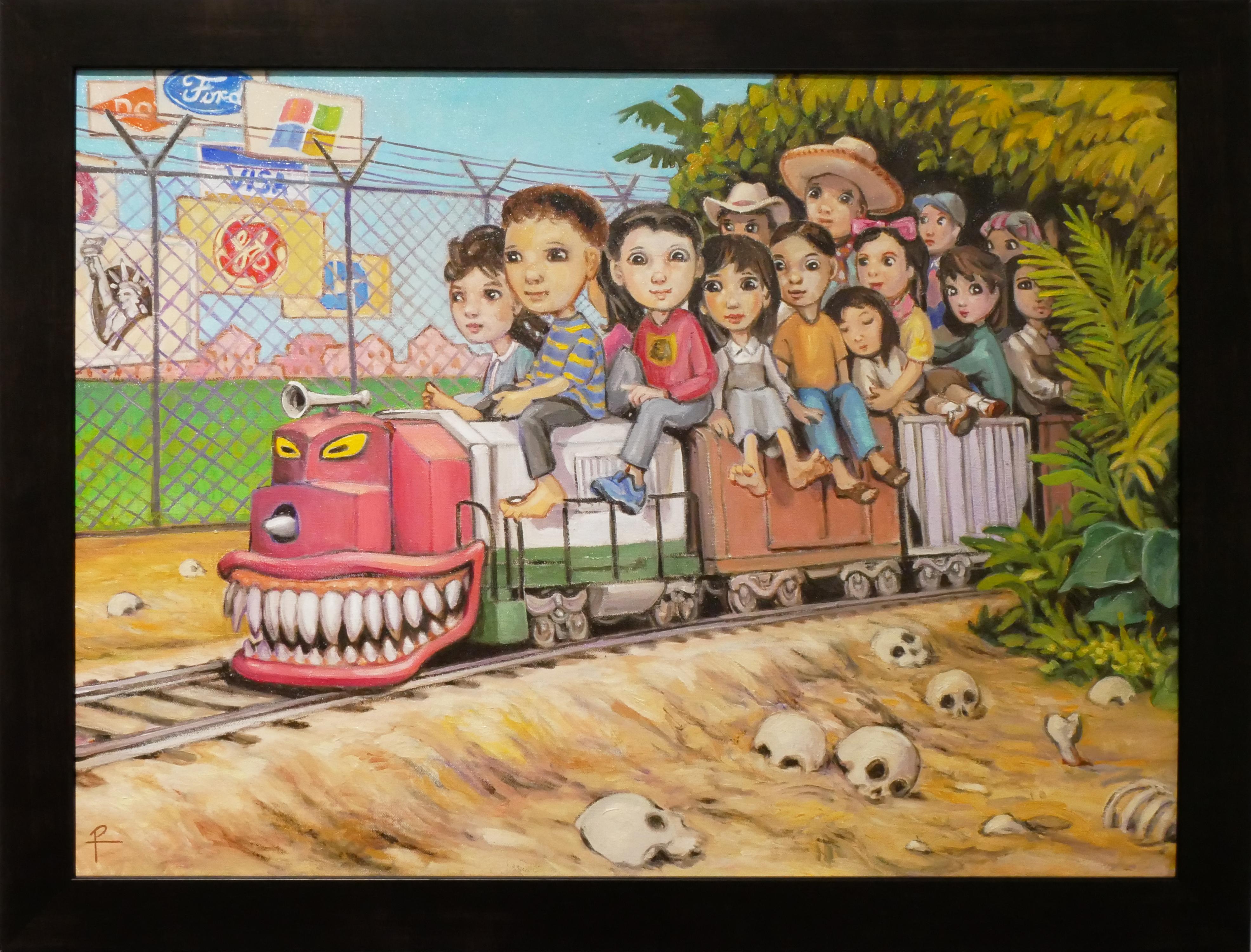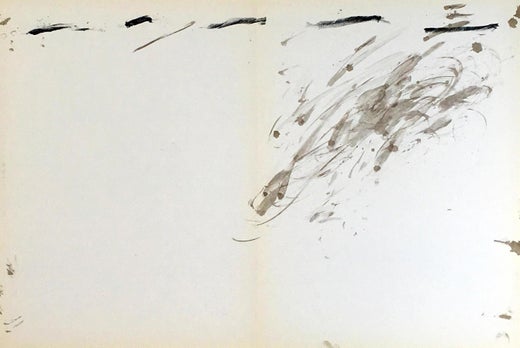Items Similar to Tapies Mid-Century Dau al Set Dada Spain Abstract Surrealism Dark Monster Signed
Want more images or videos?
Request additional images or videos from the seller
1 of 9
Antoni TàpiesTapies Mid-Century Dau al Set Dada Spain Abstract Surrealism Dark Monster Signed1949
1949
About the Item
"Sarpta" is an original oil on canvas painting created by Antoni Tapies. This is a fantastically dark mid-century abstract painting. There is a monstrous figure barely visible on the left side of the painting. Also a sinister face breathing smoke out of the right side of the painting. This piece is perfect for a collector that enjoys a more avantgarde style. Tapies signed, dated, and titled this piece on the backside of the canvas. It is currently in good restored condition. Presented in a new hand-carved, parcel gilt wood frame.
Artwork Size: 25 1/2" x 21 1/4"
Frame Size: 32 1/4" x 28"
Artist Bio:
Antoni Tàpies I Puig, 1st Marquess of Tàpies (Catalan; 13 December 1923-6 February 2012), was a Catalan Spanish painter, sculptor, and art theorist, who became one of the most important artists of the second half of the twentieth century and the best-known Spanish artist to emerge in the period after the Second World War. Largely self-taught, Tàpies first came into contact with art as a teenager through the contemporary art magazine, D’Ací i D’Allà which featured reproductions of works by Duchamp, Baque, Kandinsky, and Picasso. The artist came of age during the Spanish Civil War; his father was a Catalan nationalist and served with the republican government. At 17, he suffered a near-fatal heart attack caused by tuberculosis and spent two years as a convalescent, reading and pursuing his interest in art. He studied law for three years, and in 1943 devoted himself to art. Shortly after becoming an artist, Tàpies attended a clandestine meeting of Els Blaus (the Blues, formed in 1946), an iconoclastic group of Catalan artists and writers. In 1945 he began experimenting with non-painterly materials, mixing paint and whiting. He also became interested in philosophy, particularly Sartre and Eastern thought. In 1948, Tàpies exhibited for the first time in the controversial Salon d’Octubre in Barcelona. It was the first post-War attempt in Spain to introduce the public to new art. The same year, he co-founded, with the poet Jean Brossa, the first post-War movement in Spain known as Dau al Set (the seventh face of the die), which was connected to the Surrealist and Dadaist movements. Under the repression of the Franco regime, Surrealism became a powerful symbol of freedom and transgression for Spanish artists. Tàpies was particularly influenced by Max Ernst, Paul Klee, and Joan Miró, whom he met in 1948 and became a lifelong friend. The artist was interested in magical subjects, and gradually incorporated geometrical elements and color studies in his work.
Sarpta, an oil painting on canvas from 1949 (cat. raisonne, A. Agusti, vol. I, no. 166), is an example of Tàpies’ early, Surrealist work. At the time the work was executed, the artist was a member of the Dau al Set group. The artist’s exploration of Surrealism early in his career was foundational for his ongoing investigation into the nature of physical objects and their materiality. In this painting, the artist emulates Klee and Ernst with his depiction of obscure images surrounded by a dark atmosphere. In Sarpta, a menacing figure emerges from the dark canvas. It rears up on what appear to be human legs, defined with white paint and scratches into the painting’s surface. Its body is amorphous and it has tiny claws. It appears to be bleeding from the chest. It rears its equine head, bearing fang-like teeth and spouting a trail of smoke. Its eyes are scratched into the paint. The figure slips out of the darkness and reveals itself like a surreal pentimenti. On the creature’s back and at the picture’s lower right are partial chessboards. A red sphere appears at the right-hand side of the painting. The upper left appears to be colored smoke. The painting’s surface is scratched throughout and there is a star-like symbol scratched in the upper portion of the work. In Sarpta, Tàpies begins his lifelong interest in matter and explores the theme of transformation expressed through signs and symbols.
Tàpies was championed by the influential French art critic and curator, Michel Tapié. In 1950, Tàpies had his first solo show at Galeries Laietanes in Barcelona. He was also included in the Carnegie International in Pittsburgh. The artist received a French government scholarship in the early 1950s, and lived in Paris for a year, to which he returned frequently. In 1953, he first exhibited in the United States and he also moved away from the painterly styles of Dada and Surrealism and began working in mixed media. He became an informal artist, associated with the European movement known as Art Informel, and worked in a style known as pintura matèrica, in which non-artistic materials are incorporated into paintings. The artist added clay and marble dust to his paint and used waste paper, string and rags. By the mid-1950s, Tàpies had achieved international recognition. His works were shown in major museums and galleries throughout the United States, Europe, Japan, and South America. In the 1960s, the artist incorporated new elements in his works—writing, signs, anthropomorphic elements, footprints, and references to the Catalan situation. He employed new technical methods such as new surfaces, use of everyday objects, and varnish. His work of the early 1970s is marked by symbols of Catalan identity. From around 1970, influenced by Pop Art, Tàpies began incorporating more substantial objects into his paintings such as furniture. Although his work defies clear labels, he has been associated with Tachisme and Abstract Expressionism. The artist emphasized the raw materiality of his works and by bringing together different objects, Tàpies invokes the Surrealist technique of juxtaposition in which objects take on a new order of meaning when taken out their familiar contexts and placed together. He shares a visual vocabulary with contemporaneous Neo-Expressionist artists Francesco Clemente, Julian Schnabel, Cy Tyombly, Anselm Kiefer, and Jean-Michel Basquiat.
Exhibitions of Tàpies’ work include: The Museum of Modern Art, New York; The Guggenheim Museum, New York; The Museum of Contemporary Art, Los Angeles; Serpentine Gallery, London; Hayward Gallery, London; Neue Nationalgalerie, Berlin; Kunsthaus, Zurich Stedelijk Museum, Amsterdam; Haus der Kunst, Munich; Musée d’art Moderne de la Ville de Paris; Jeu de Paume, Paris; Centre Georges Pompidou, Paris; Museo Nacional Centro de Arte Reina Sofia, Madrid; Institut Valencia d’Art Moderna, Valencia; Museu d’Art Contemporani de Barcelona. The artist’s publications: La practica de l’art (1970); L’art contra l’estetica (1974); Memoria personal (1977); La realitat com a art (1982); Per un art modern I progressista (1985); Valor de l’art (1993); L’art I els lloc (1999). In 1984, The artist created the Fundació Tàpies with the aim of promoting the study and knowledge of modern and contemporary art.
- Creator:Antoni Tàpies (1923 - 2012, Spanish)
- Creation Year:1949
- Dimensions:Height: 32.25 in (81.92 cm)Width: 28 in (71.12 cm)
- Medium:
- Movement & Style:
- Period:
- Condition:In good restored condition.
- Gallery Location:Milwaukee, WI
- Reference Number:
Antoni Tàpies
Antoni Tàpies is considered to be Spain's most important painter after Picasso. His work is in the collections of the most important modern and contemporary museums around the world, as well as those of the most notable private collectors. Tàpies’s ultra-typical style was an almost industrial look, expressionistic slashes, thick impasto, rough and impassioned.
About the Seller
4.9
Platinum Seller
These expertly vetted sellers are 1stDibs' most experienced sellers and are rated highest by our customers.
Established in 1966
1stDibs seller since 2017
392 sales on 1stDibs
Typical response time: 1 hour
- ShippingRetrieving quote...Ships From: Milwaukee, WI
- Return PolicyA return for this item may be initiated within 14 days of delivery.
More From This SellerView All
- "Sunrise, " an Abstract Expressionist Oil on Canvas signed by Matthew SchaeferBy Matthew SchaeferLocated in Milwaukee, WI"Sunrise," by American artist Matthew Schaefer, is a fauvist expressionist painting with bold, bright colors and gestural marks in a style similar to the abstractionists Willem de Ko...Category
1990s Neo-Expressionist Abstract Paintings
MaterialsCanvas, Oil
- "Everyone Has Gone, " an Abstract Oil on Canvas signed by Deidre SchanenBy Deirdre SchanenLocated in Milwaukee, WI"Everyone Has Gone" is an abstract oil painting on canvas by Deirdre Schanen. Working in the color-field tradition established by such artists as Helen Frankenthaler and Mark Rothko,...Category
Early 2000s Color-Field Abstract Paintings
MaterialsCanvas, Oil
- "Except for Then, " an Abstract Oil Painting on Canvas by Dierdre SchanenBy Deirdre SchanenLocated in Milwaukee, WI"Except for Then" is a contemporary abstract painting of warm golds, pinks, peach and orange. Oil on canvas, signed on verso. 2010 48" x 36" canvas Deirdre Schanen artist statemen...Category
2010s Abstract Abstract Paintings
MaterialsCanvas, Oil
- "Naked Loneliness, " an Abstract Oil Painting on Canvas by Dierdre SchanenBy Deirdre SchanenLocated in Milwaukee, WI"Naked Loneliness" is a contemporary abstract landscape painting of light blue, light green, orange, violet and green. Oil on canvas, 2014. The artist signed the piece on the verso....Category
2010s Abstract Paintings
MaterialsCanvas, Oil
- "Silence and Distance, " an Abstract Oil Painting on Canvas by Dierdre SchanenBy Deirdre SchanenLocated in Milwaukee, WI"Silence and Distance" is a contemporary abstract painting of light green, pink, black and gold. Oil on canvas, 2016. The artist signed the artwork on the verso. 48" x 36" canvas ...Category
2010s Abstract Expressionist Abstract Paintings
MaterialsCanvas, Oil
- "Puck, " Unique Oil Portrait Painting on Canvas signed by Matthew SchaeferBy Matthew SchaeferLocated in Milwaukee, WI"Puck" is an original portrait oil painting on canvas by Matthew Schaefer. The abstracted figure is a unique and colorful design priced under $3000. It's sizing makes it perfect for ...Category
1990s Abstract Abstract Paintings
MaterialsCanvas, Oil
You May Also Like
- Surrealist Landscape Una Via Romana Antica con Temporale Distante. Italian SceneBy Eugene BermanLocated in Miami, FLSigned "E.B." in a cartouche panel in the upper center, which is repeated on the verso. Includes 19 on the left side and 62 on the right side. h: 33.2 x w: 19.5 in / h: 84.3 x w: 49...Category
1960s Surrealist Landscape Paintings
MaterialsOil, Canvas
- L'epreuveBy Roberto MattaLocated in Palm Desert, CAA painting by Roberto Matta. "L'epreuve" is a surrealist painting, oil on canvas in palette of grays, greens, and yellows by Latin American artist Roberto Matta. It is signed in the ...Category
Mid-20th Century Surrealist Abstract Paintings
MaterialsCanvas, Oil
- Surrealist Woman Oil painting French-Moroccan Israeli Bezalel School PainterBy Simon AvissarLocated in Surfside, FLTwo Women. Colorful Surrealist Portrait Genre: Surrealism Subject: woman Medium: Oil Surface: Canvas Country: Israel Simon Avissar, painter, born 1948, Morocco. Moved to U.S.A. Wo...Category
20th Century Surrealist Figurative Paintings
MaterialsCanvas, Oil
- "Junk Food (Pizza)" Contemporary Surrealist Still Life of an Inedible PizzaBy Henry David PotwinLocated in Houston, TXColorful surrealist still life painting by contemporary Texas artist Henry David Potwin. The work features an opened pizza box with a variety of inedible toppings including items suc...Category
2010s Surrealist Still-life Paintings
MaterialsCanvas, Oil
- "La Bestia" Contemporary Surrealist Border Train Commentary PaintingBy Henry David PotwinLocated in Houston, TXColorful surrealist portrait painting by contemporary Texas artist Henry David Potwin. The work features a crowded group of children riding on a monstrous train flanked by skeletons ...Category
2010s Surrealist Figurative Paintings
MaterialsCanvas, Oil
- "Junkman" Pastel Contemporary Biomechanical Surrealist Desert PaintingBy Henry David PotwinLocated in Houston, TXPastel surrealist painting by contemporary Texas artist Henry David Potwin. The work features a large mechanized man wandering a desert landscape. Signed in front lower left corner. ...Category
Early 2000s Surrealist Figurative Paintings
MaterialsCanvas, Oil
Recently Viewed
View AllMore Ways To Browse
Mid Century Abstract Painting
Mid Century Abstract Paintings
Signed Spanish Painting
Abstract Signed Midcentury
Vintage Mid Century Abstract Painting
Modern Surrealism
Vintage Midcentury Modern Abstract Paintings
Dior 1949
17 Century Spanish
Abstract Time Art Mid Century
Mid Modern Dark Art
London Midcentury Paintings
Surrealism Original Painting
Mid Century Abstract Expressionism
Midcentury Abstract Expressionism
Abstract Reproductions
Mid Century Surrealism Art
American Surrealism Painting





